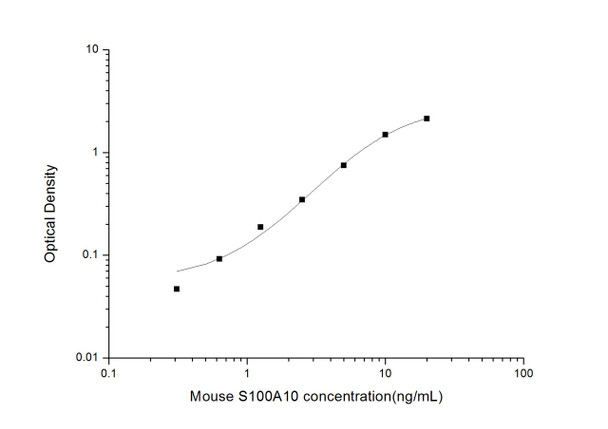Mouse Cell Biology ELISA Kits 1
Mouse S100A10 (S100 Calcium-binding Protein A10) ELISA Kit (MOES01658)
- SKU:
- MOES01658
- Product Type:
- ELISA Kit
- Size:
- 96 Assays
- Uniprot:
- P08207
- Sensitivity:
- 0.19ng/mL
- Range:
- 0.31-20ng/mL
- ELISA Type:
- Sandwich
- Reactivity:
- Mouse
- Sample Type:
- Serum, plasma and other biological fluids
Description
| Assay type: | Sandwich |
| Format: | 96T |
| Assay time: | 4.5h |
| Reactivity: | Mouse |
| Detection Method: | Colormetric |
| Detection Range: | 0.31-20 ng/mL |
| Sensitivity: | 0.19 ng/mL |
| Sample Volume Required Per Well: | 100µL |
| Sample Type: | Serum, plasma and other biological fluids |
| Specificity: | This kit recognizes Mouse S100A10 in samples. No significant cross-reactivity or interference between Mouse S100A10 and analogues was observed. |
This ELISA kit uses Sandwich-ELISA as the method. The micro ELISA plate provided in this kit has been pre-coated with an antibody specific to Mouse S100A10. Standards or samples are added to the appropriate micro ELISA plate wells and combined with the specific antibody. Then a biotinylated detection antibody specific for Mouse S100A10 and Avidin-Horseradish Peroxidase (HRP) conjugate are added to each micro plate well successively and incubated. Free components are washed away. The substrate solution is added to each well. Only those wells that contain Mouse S100A10, biotinylated detection antibody and Avidin-HRP conjugate will appear blue in color. The enzyme-substrate reaction is terminated by adding Stop Solution and the color turns yellow. The optical density (OD) is measured spectrophotometrically at a wavelength of 450 nm ± 2 nm. The OD value is proportional to the concentration of Mouse S100A10. The concentration of Mouse S100A10 in samples can be calculated by comparing the OD of the samples to the standard curve.
| UniProt Protein Function: | S100A10: Because S100A10 induces the dimerization of ANXA2/p36, it may function as a regulator of protein phosphorylation in that the ANXA2 monomer is the preferred target (in vitro) of tyrosine- specific kinase. Heterotetramer containing 2 light chains of S100A10/p11 and 2 heavy chains of ANXA2/p36. Interacts with SCN10A. Belongs to the S-100 family. |
| UniProt Protein Details: | Protein type:Calcium-binding Chromosomal Location of Human Ortholog: 1q21 Cellular Component: extrinsic to plasma membrane; lipid raft Molecular Function:protein binding; protein homodimerization activity; calcium ion binding; lipid binding Biological Process: positive regulation of focal adhesion formation; positive regulation of stress fiber formation; protein heterotetramerization; positive regulation of binding; lipid raft formation; membrane budding |
| NCBI Summary: | The protein encoded by this gene is a member of the S100 family of proteins containing 2 EF-hand calcium-binding motifs. S100 proteins are localized in the cytoplasm and/or nucleus of a wide range of cells, and involved in the regulation of a number of cellular processes such as cell cycle progression and differentiation. S100 genes include at least 13 members which are located as a cluster on chromosome 1q21. This protein may function in exocytosis and endocytosis. [provided by RefSeq, Jul 2008] |
| UniProt Code: | P08207 |
| NCBI GenInfo Identifier: | 46397706 |
| NCBI Gene ID: | 6281 |
| NCBI Accession: | P60903. 2 |
| UniProt Secondary Accession: | P08207,P08207, |
| UniProt Related Accession: | P60903 |
| Molecular Weight: | 11kDa |
| NCBI Full Name: | Protein S100-A10 |
| NCBI Synonym Full Names: | S100 calcium binding protein A10 |
| NCBI Official Symbol: | S100A10 |
| NCBI Official Synonym Symbols: | 42C; P11; p10; GP11; ANX2L; CAL1L; CLP11; Ca[1]; ANX2LG |
| NCBI Protein Information: | protein S100-A10 |
| UniProt Protein Name: | Protein S100-A10 |
| UniProt Synonym Protein Names: | Calpactin I light chain; Calpactin-1 light chain; Cellular ligand of annexin II; S100 calcium-binding protein A10; p10 protein; p11 |
| Protein Family: | Protein |
| UniProt Gene Name: | S100A10 |
| UniProt Entry Name: | S10AA_HUMAN |
As the OD values of the standard curve may vary according to the conditions of the actual assay performance (e. g. operator, pipetting technique, washing technique or temperature effects), the operator should establish a standard curve for each test. Typical standard curve and data is provided below for reference only.
| Concentration (ng/mL) | O.D | Average | Corrected |
| 20 | 2.19 2.202 | 2.196 | 2.139 |
| 10 | 1.519 1.577 | 1.548 | 1.491 |
| 5 | 0.805 0.803 | 0.804 | 0.747 |
| 2.5 | 0.394 0.418 | 0.406 | 0.349 |
| 1.25 | 0.246 0.244 | 0.245 | 0.188 |
| 0.63 | 0.163 0.135 | 0.149 | 0.092 |
| 0.31 | 0.104 0.104 | 0.104 | 0.047 |
| 0 | 0.055 0.059 | 0.057 | -- |
Precision
Intra-assay Precision (Precision within an assay): 3 samples with low, mid range and high level Mouse S100A10 were tested 20 times on one plate, respectively.
Inter-assay Precision (Precision between assays): 3 samples with low, mid range and high level Mouse S100A10 were tested on 3 different plates, 20 replicates in each plate.
| Intra-assay Precision | Inter-assay Precision | |||||
| Sample | 1 | 2 | 3 | 1 | 2 | 3 |
| n | 20 | 20 | 20 | 20 | 20 | 20 |
| Mean (ng/mL) | 0.95 | 2.36 | 8.25 | 0.91 | 2.32 | 7.79 |
| Standard deviation | 0.05 | 0.13 | 0.42 | 0.06 | 0.11 | 0.41 |
| C V (%) | 5.26 | 5.51 | 5.09 | 6.59 | 4.74 | 5.26 |
Recovery
The recovery of Mouse S100A10 spiked at three different levels in samples throughout the range of the assay was evaluated in various matrices.
| Sample Type | Range (%) | Average Recovery (%) |
| Serum (n=5) | 84-95 | 90 |
| EDTA plasma (n=5) | 89-101 | 95 |
| Cell culture media (n=5) | 86-98 | 91 |
Linearity
Samples were spiked with high concentrations of Mouse S100A10 and diluted with Reference Standard & Sample Diluent to produce samples with values within the range of the assay.
| Serum (n=5) | EDTA plasma (n=5) | Cell culture media (n=5) | ||
| 1:2 | Range (%) | 91-105 | 87-101 | 98-114 |
| Average (%) | 97 | 94 | 105 | |
| 1:4 | Range (%) | 88-100 | 83-96 | 86-98 |
| Average (%) | 95 | 88 | 91 | |
| 1:8 | Range (%) | 86-99 | 84-96 | 84-97 |
| Average (%) | 92 | 90 | 90 | |
| 1:16 | Range (%) | 91-107 | 85-98 | 83-96 |
| Average (%) | 99 | 92 | 90 |
An unopened kit can be stored at 4°C for 1 month. If the kit is not used within 1 month, store the items separately according to the following conditions once the kit is received.
| Item | Specifications | Storage |
| Micro ELISA Plate(Dismountable) | 8 wells ×12 strips | -20°C, 6 months |
| Reference Standard | 2 vials | |
| Concentrated Biotinylated Detection Ab (100×) | 1 vial, 120 µL | |
| Concentrated HRP Conjugate (100×) | 1 vial, 120 µL | -20°C(shading light), 6 months |
| Reference Standard & Sample Diluent | 1 vial, 20 mL | 4°C, 6 months |
| Biotinylated Detection Ab Diluent | 1 vial, 14 mL | |
| HRP Conjugate Diluent | 1 vial, 14 mL | |
| Concentrated Wash Buffer (25×) | 1 vial, 30 mL | |
| Substrate Reagent | 1 vial, 10 mL | 4°C(shading light) |
| Stop Solution | 1 vial, 10 mL | 4°C |
| Plate Sealer | 5 pieces | |
| Product Description | 1 copy | |
| Certificate of Analysis | 1 copy |
- Set standard, test sample and control (zero) wells on the pre-coated plate and record theirpositions. It is recommended to measure each standard and sample in duplicate. Note: addall solutions to the bottom of the plate wells while avoiding contact with the well walls. Ensuresolutions do not foam when adding to the wells.
- Aliquot 100µl of standard solutions into the standard wells.
- Add 100µl of Sample / Standard dilution buffer into the control (zero) well.
- Add 100µl of properly diluted sample (serum, plasma, tissue homogenates and otherbiological fluids) into test sample wells.
- Cover the plate with the sealer provided in the kit and incubate for 90 min at 37°C.
- Aspirate the liquid from each well, do not wash. Immediately add 100µL of BiotinylatedDetection Ab working solution to each well. Cover the plate with a plate seal and gently mix. Incubate for 1 hour at 37°C.
- Aspirate or decant the solution from the plate and add 350µL of wash buffer to each welland incubate for 1-2 minutes at room temperature. Aspirate the solution from each well andclap the plate on absorbent filter paper to dry. Repeat this process 3 times. Note: a microplatewasher can be used in this step and other wash steps.
- Add 100µL of HRP Conjugate working solution to each well. Cover with a plate seal andincubate for 30 min at 37°C.
- Aspirate or decant the solution from each well. Repeat the wash process for five times asconducted in step 7.
- Add 90µL of Substrate Reagent to each well. Cover with a new plate seal and incubate forapproximately 15 min at 37°C. Protect the plate from light. Note: the reaction time can beshortened or extended according to the actual color change, but not by more than 30min.
- Add 50 µL of Stop Solution to each well. Note: Adding the stop solution should be done inthe same order as the substrate solution.
- Determine the optical density (OD value) of each well immediately with a microplate readerset at 450 nm.






